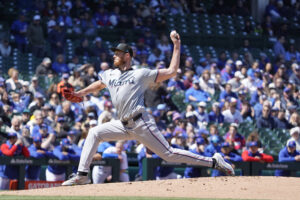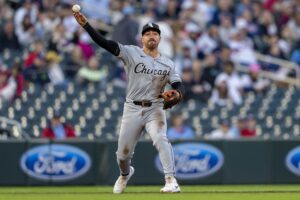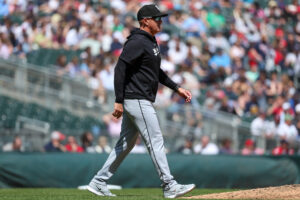This is the article that wasn’t. I did not set out to write this article. I had an entirely different premise in mind, did loads of research, and wrote an entirely different article. There was only one problem: I was wrong.
Originally, I wanted to publish an article about how even players as young and talented as Bryce Harper or Manny Machado were risks in free agency. The problem was that the numbers did not support what I was writing. I made two mistakes. First, I believed the hype. The narrative has always been about a potentially record-setting contract. However, when I actually looked, that offer is not there. It could happen, but teams are wary of such pacts. Secondly, I started with a story in mind and tried to twist the numbers to suit the story. As you might expect, it did not work. So here I am, with an entirely unexpected article telling you that someone should probably give these guys some super serious cash.
Bryce Harper, Manny Machado Might Actually Be Worth It
The Precedent: Greg Maddux
Every year in nearly every sport, teams spend absurd amounts of money on signing or re-signing talented players. Sometimes, these moves are tremendously successful and change the course of a franchise or career. In 1993, Ted Turner opened his checkbook to lure 26-year-old Greg Maddux to the Atlanta Braves. Maddux went on the win three straight Cy Young awards and helped the Braves to the 1995 World Series. It was every team’s dream signing: a young, impact star at his peak, who immediately delivers on his promise.
Admittedly, Maddux was a pitcher and pitchers have a different aging curve than position players. That does not negate the fact that Maddux was a young star of a similar age who cemented himself as an all-time great with his new team. He did not need to bear the weight of a rebuild or turning the club around as the Braves were already on the rise. In a similar vein, Harper and Machado could easily step into those same shoes for a variety of young clubs on the rise.
The Precedent 2: Alex Rodriguez
Everyone knows the drama, the steroids, the mirror-kissing selfies, the postseason struggles. What people tend to forget is that at one point A-Rod was a 25-year-old free agent. That’s a year younger than Harper and Machado are now. All Rodriguez did was sign one of the largest contracts in history with the Texas Rangers, then flat out rake for three seasons before being traded to the New York Yankees. That the Rangers could not afford to put a good team around him is not his fault. Three top-10 MVP finishes, one MVP trophy, 156 home runs and 25.5 bWAR tell the real story. The Rangers signed him to be a superstar, and he more than delivered.
Initially, Rodriguez delivered in New York, too. For the remaining four years of his first monster contract, he contributed 30.9 bWAR, two MVP awards, and 173 home runs. Maybe not quite as good as his numbers in Texas but still great. That leaves his seven-year deal producing an astounding 329 home runs, three MVP awards, and 56.4 bWAR. Whatever standard you hold a star too, he delivered. He’s remembered as one example in a long list of bad long-term contracts, and that’s a mistake. Rodriguez signed two long-term deals in his career, and while the second was a mistake, the first produced some of the greatest baseball ever.
The Precedent 3: Miguel Cabrera
The other member of baseball’s two mega-deal club, Cabrera’s career parallels Rodriguez’s in many ways. It’s hard not to look at the aging, oft-injured version of Miguel Cabrera and wince at the implications of long-term deals. But much like Rodriguez, the mistake is the second deal and not the first.
In 2008, again at the age of 25, Cabrera signed an extension with the Detroit Tigers to run through 2015. Those eight seasons produced five top-5 MVP finishes, 2 MVP trophies, 270 home runs and 46.6. bWAR. While his glove never allowed him to play a premium defensive position, his bat made him a star. Much like Rodriguez, he got a second mega-deal because there had been absolutely no reason to regret the first.
The Numbers Now
While not strictly comparable, Giancarlo Stanton signed his massive contract with the Miami Marlins after his age-23 season, and all he’s done is accumulate 188 home runs, an MVP trophy, and 24.4 bWAR since. If a player is young enough, a mega-contract, even a long one, does not have to be a mistake.
Since 2010, there have been exactly eight position players aged 30 or older to rank among the top 10 in bWAR:
| Player | Latest Year | Oldest Age | bWAR | Rank (Overall) |
| Joey Votto | 2017 | 33 | 7.5 | 4 (5) |
| Josh Donaldson | 2016 | 30 | 7.7 | 4 (4) |
| Adrian Beltre | 2014 | 35 | 6.7 | t3 (t7) |
| Jose Bautista | 2014 | 33 | 6.7 | t3 (t7) |
| Robinson Cano | 2013 | 30 | 7.8 | 4 (5) |
| Miguel Cabrera | 2013 | 30 | 7.3 | 6 (7) |
| Ben Zobrist | 2011 | 30 | 7.6 | 7 (10) |
| Albert Pujols | 2010 | 30 | 7.5 | 5 (6) |
There are a few interesting things to note here.
- Beltre is an enigma, wrapped in a mystery, surrounded by an anomaly, at the heart of a black hole. He had his best season at 25 but had his best decade from 30-39. That just does not happen.
- Bautista, Donaldson, and even Zobrist were all relatively late bloomers. The fact that they had their strongest seasons in their early thirties says more about when they developed than it does their careers.
The Future
That leads us to this:
| Player | Peak bWAR (age) | bWAR by 26 | bWAR After 6 Seasons | Age After 6 Seasons | Career bWAR |
| Albert Pujols | 9.7 (29) | 46.1 | 46.1 | 26 | 100 |
| Joey Votto | 7.7 (31) | 15.1 | 34.3 | 29 | 58.8 |
| Miguel Cabrera | 7.6 (28) | 26.1 | 26.1 | 26 | 69.4 |
| Robinson Cano | 8.4 (29) | 15.4 | 23.5 | 27 | 69.2 |
| Adrian Beltre | 9.6 (25) | 26.6 | 26.6 | 25 | 95.7 |
| Jose Bautista | 8.3 (30) | -2.9 | 0 | 28 | 35.6 |
| Josh Donaldson | 8.5 (29) | 1.2 | 37.2 | 37.2 | 38.5 |
| Ben Zobrist | 8.6 (28) | -1.7 | 36 | 33 | 45.3 |
| Bryce Harper | 10.0 (22) | 27.4 | 27.4 | 25 | 27.4 |
| Manny Machado | 7.1 (22) | 33.8 | 33.8 | 25 | 33.8 |
Three things stand out here:
- Harper’s best season stands up to anyone’s.
- With the exception of Pujols, every other player accumulated the vast majority of their career WAR after their age 26 season.
- These guys were not occasional all-stars. They were face of the franchise type superstars.
The Truth
While the sample size is small, there is historical precedent for the idea that superstars, true superstars, can produce at that level for a long time. Everyone is rightfully wary of paying superstar money for a declining player, but I think this is a case of being too cautious. There is every chance in the world that Harper and Machado can continue playing at a superstar level for another six or seven years each. If you get seven years of superstardom, an MVP season or two and a few deep runs through the playoffs, fans will begrudge a few years of paying for memories. Ergo, Harper and Machado are the rare free agents who just might be worth it.
Main Photo:
Embed from Getty Images






